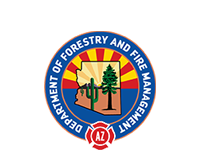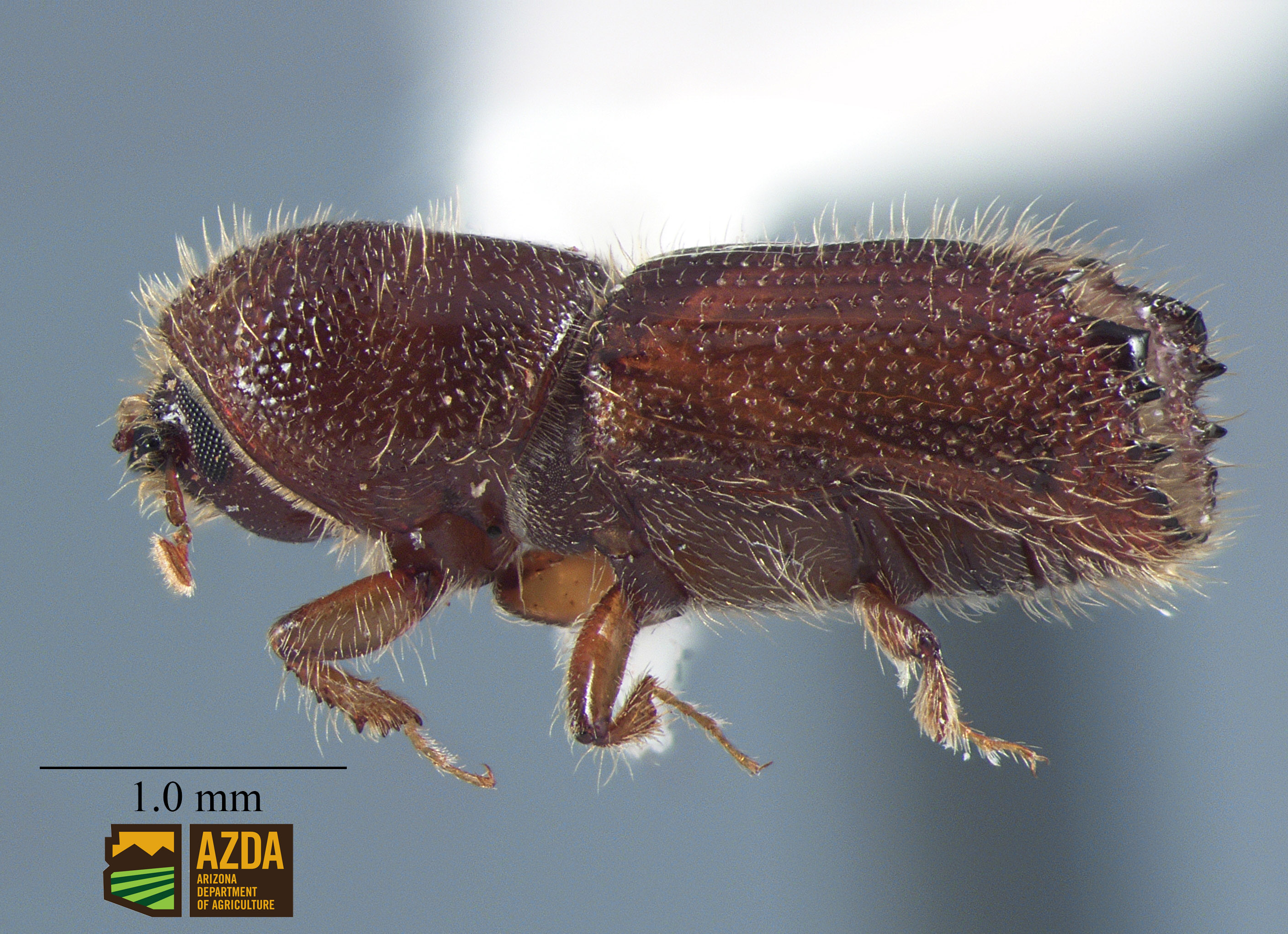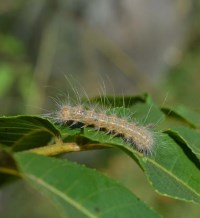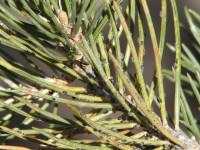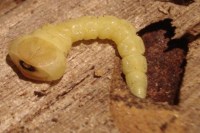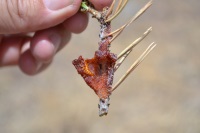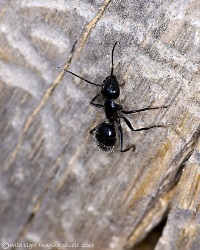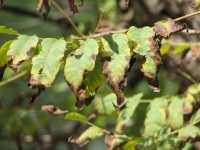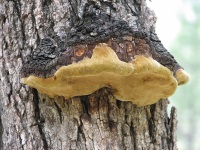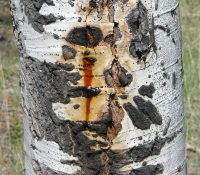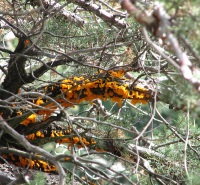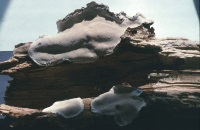Insects and Diseases
Primary tabs
| Insects | Diseases |
Arizona's Forest Insect Pests
Alert: Firewood and wood packaging materials can harbor invasive tree-killing pests like emerald ash borer, spongy moth, spotted lanternfly, and Asian longhorned beetle. Source your firewood from local vendors and, when fire restrictions allow, burn it near where you buy it. Do not travel long distances with firewood and do not bring firewood into Arizona from out of state. Inspect wood packaging material prior to shipment or travel. Help protect Arizona trees.
|
Mediterranean Pine Engraver - Bark Beetle (Orthotomicus erosus) |
Bark Beetles Bark Beetles are small insects—about the size of a grain of rice—that feed by tunneling between the bark and wood of a tree, mainly in conifer trees in Arizona. A tree that has succumbed to bark beetles will have foliage/needles that are the color of straw to red. Localized populations of bark beetles typically prefer weakened or stressed trees; however, they attack even healthy trees under epidemic conditions. Common bark beetles in Arizona include: Pine Engraver beetles (Ips species) and Douglas-fir, Mountain, Red Turpentine, Roundheaded, Southern, Spruce, and Western pine beetles (Dendroctonus species). Also, cedar, cypress, or juniper beetles (Phloeosinus species). The Mediterranean Pine Engraver (MPE) is a non-native bark beetle that recently reached the Phoenix and Tucson metro areas. First found in Phoenix in 2018, MPE has become a serious threat to urban pines. MPE attacks stressed trees by boring holes into the bark and feeding on the tree's outer layers. Galleries created by MPE limit the tree’s ability to transport water and nutrients, ultimately killing the tree. Monitoring for this pest concluded in 2022, with over 355,000 MPE captured in Phoenix and Tucson. Trapping efforts in 2023 found small numbers of MPE in Kingman, Topock, Pinetop-Lakeside, Superior, and Nogales. Information on where MPE has been found in Arizona can be located on the MPE Monitoring Dashboard. |
|
Fall Webworm - Moth Caterpillar (Hyphantria cunea) |
Defoliating Insects Defoliating insects feed on photosynthetic tissue—leaves and needles—of suitable hosts. The loss of this photosynthetic tissue impacts the plant's health, and the severity depends on a variety of factors, including host species tolerance, timing of defoliation, and the relative destructiveness of a particular insect. A tree that defoliators have attacked may be lightly to completely defoliated. Repeated defoliation may cause branch or tree mortality. Defoliation can lead to poor tree health and, subsequently, make trees more prone to additional insect attacks, especially in our unhealthy forests and woodlands. |
|
Pinyon Needle Scale (Matsucoccus acalyptus) |
Sap-sucking Insects Sap-sucking insects are small insects that pierce the foliage or stem of host plants to feed on their food and water supply. This injury to the plant can cause discoloration of the host tissue and occasionally introduce plant diseases. A tree that has been attacked by sap-sucking insects will have discolored, deformed leaves/needles or no previous year’s needles, but host mortality is uncommon. Notable sap-sucking insects in Arizona include aphids, Cooley spruce gall adelgids, pinyon needle scales, and spider mites, which are not related to insects. |
|
Jewel Beetle Larva (Buprestidae) |
Wood-boring Beetles Wood-borers are insects that bore into the wood of host trees that are freshly cut, injured, dying, or recently dead. They are mainly secondary and help to recycle the woody material. Boring dust and entrance or exit holes on the bark or surface of the wood are diagnostic. Prominent wood-borers in Arizona include ambrosia, jewel, and longhorned beetles. |
|
Pinyon Pitch Nodule Moth (Synanthedon sp) pupa |
Bud and Shoot Insects Injury may be caused by directly feeding on the buds and shoots of host plants, drilling directly into the twig or branch, or boring into the bark, producing excess resin or pitch. Common species include bark and pitch moths, pine tip moths, twig beetles, and juniper and oak pruners. |
|
Carpenter Ant (Camponotus laevigatus) |
Insects of Wood Products Wood products are susceptible to insects looking for both food and shelter. Materials that these insects have attacked will have boring dust, exit holes, or honeycomb-shaped damage that follows the wood grain. Insects of wood products in Arizona include the wood borers listed previously, carpenter ants, termites, and carpenter bees. |
Arizona's Forest Diseases
|
Walnut Anthracnose (Anthracnose sp) |
Foliage Diseases Foliage diseases are most commonly seen in Arizona on aspen, Arizona sycamore, oak, cottonwood, and willow. Individual trees or whole groups can become infected when favorable moisture conditions occur. Heavy infections can cause partial or complete defoliation of infected trees, reducing growth and causing scattered dieback of twigs and branches. Black leaf spot, Melampsora rust, and oak and sycamore anthracnose are the most common species identified. On conifers, foliage diseases are less common but may be very dramatic when they occur, causing infected needles to discolor and fall off. The most common conifer needle diseases include Elytroderma needle cast, Red band needle blight of ponderosa and pinyon pine, and Rhabdocline needle cast of Douglas-fir. |
|
Phellinus everhartii on Walnut |
Stem and Trunk Decays Decay of wood is caused by fungi that infect both living heartwood and dead wood, and sometimes both. Decaying fungi also serve a critical role in nature, recycling nutrients back into the soil for utilization by other organisms. Most decay fungi of live trees do not kill infected trees but may structurally weaken the branch or trunk, causing wind breakage and windthrow. This is usually correlated with the tree's age and the extent of decay. Hardwoods, including aspens and cottonwoods, are highly susceptible to stem and trunk decay. Conifers, including Douglas-fir, white-fir, and spruce, are generally more susceptible mainly due to the wetter and cooler environments they inhabit. Conversely, pines are less susceptible due to the warmer and drier habitats in which they occur. Common decays found on hardwoods include false tinder conk on aspen, which produces conspicuous hoof-shaped conks or fruiting bodies clearly visible on the trunk. Very dramatic and large fruiting bodies of sulfur-shelf fungus can be seen on oaks and poplars, and heart rots and canker rot of oaks and New Mexican Locust are fairly common. On conifers, multiple fruiting bodies or conks of red ring rot can be detected on the trunk of infected Douglas-firs and pines. Red belt fungus also produces shelf-like perennial conks with a red-brown band above a light-colored base on dead conifers. |
|
Cytospora Canker (Cytospora chrysosperma) |
Cankers Localized areas of dead bark and underlying wood on twigs, branches, and trunks caused by fungi are called cankers. They are usually a response to injury and are usually found on hardwoods. Aspen is the most common host of these diseases because of its soft bark tissue, but also alders and cottonwoods. Cankers seen on aspen include Black, Cryptosphaeria, Cytospora, Hypoxylon, and Sooty Bark, which is considered the most damaging. Cankers are less common on conifers, and Atropellis canker has been identified on limber, ponderosa, and SW white pine. |
|
Gymnosporangium Rust (Gymnosporangium sp) |
Stem Rusts Some stem rust fungi can have a complex multispecies lifecycle, while others can complete their life cycle on only one host. Rusts can cause brooms, galls, flagged and swollen branches, trunk dieback, and mortality of conifers. The most notable and destructive stem rust recently identified in Arizona is the non-native white pine blister rust. Comandra blister rust, a native species, has also been identified in the past on a non-native pine, Pinus eldarica. Other species include Limb rust, Western Gall rust, Fir and Spruce broom rusts, and gymnosporangium rusts on Arizona cypress and junipers. |
|
Annosus Root Rot (Heterobasidion irregulare) |
Root Diseases Root diseases decay and kill roots, heartwood, and sapwood of conifers and hardwoods. Severity varies depending on root disease species, age of host, and growing site history. Principal symptoms include yellowing of the leaves/needles, shortened terminal growth, reduced needle length, progressive thinning of foliage, fading crown, and reduced tree growth. Arizona's tree species susceptible to root disease fungi include aspen, oak, Douglas-fir, ponderosa pine, fir, and spruce. Prominent root diseases include Armillaria, Annosus, Ganoderma, and Velvet Top fungus. Bark beetles may also infest trees heavily infected by root diseases. |
